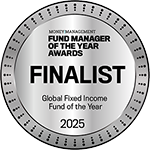
Your Fixed Income Solution
The Fund aims to exploit mispriced sectors using a relative value approach and has a focus on downside protection2.
1 Neuberger Berman Strategic Income Fund (Fund) is an Australian managed investment scheme structured as a unit trust, which has been registered with ASIC (ARSN 633 772 255) and was launched in Australia on 1 July 2019. The Fund is a feeder fund into the AUD Z Distributing share class of the Neuberger Berman Investment Fund plc – Neuberger Berman Strategic Income Fund (Underlying UCITS Fund), which was launched in Europe in April 2013. 2 Investors’ capital is not guaranteed. Downside protection is incorporated in the Investment Strategy through the security selection process, portfolio construction techniques and ongoing risk management, with the aim of reducing the frequency and/or magnitude of losses.
Diversified, multi-sector fixed income strategy that invests across global fixed income markets
Flexible sector and intra-sector asset allocation that is adaptive to changing market conditions, based on conviction and a relative value approach
Seeks to deliver consistent monthly income while achieving attractive total returns
Agile and tactical portfolio management
1 Refer to the fund factsheet for monthly income figures. 2 Investors’ capital is not guaranteed. Downside protection is incorporated in the Investment Strategy through the security selection process, portfolio construction techniques and ongoing risk management, with the aim of reducing the frequency and/or magnitude of losses.









‘A Target Market Determination is a document which is required to be made available from 5 October 2021. It describes who this financial product is likely to be appropriate for (i.e. the target market), and any conditions around how the product can be distributed to investors. It also describes the events or circumstances where the Target Market Determination for this financial product may need to be reviewed.
Continuous collaboration is at the center of our effort as it allows for the best of investment insights globally to be reflected in portfolios.
Our process combines macro inputs, relative value analysis and fundamental research to drive informed decision-making and consistent investment performance.
Fundamental research that integrates ESG considerations allows for a differentiated understanding of potential value and, more importantly, the risk of loss.
100% Fixed Income AUM evaluates ESG factors in fundamental credit research process.
As at September 30, 2025. 1 Neuberger Berman’s fixed income business traces its roots back to the 1981 formation of a predecessor firm, Lincoln Capital. 2 Includes public fixed income (US$220bn) and private credit (US$45bn) but excludes fixed income assets (US$6bn) managed by private wealth management and quantitative multi-asset class teams and includes broad mandate sleeves (US$5bn).
Ashok Bhatia, CFA
Jon Jonsson
Thanos Bardas, PhD
David M. Brown, CFA
Adam Grotzinger, CFA
Robert Dishner
Thomas Sobanski

/Citywire_202508_circular.png)













